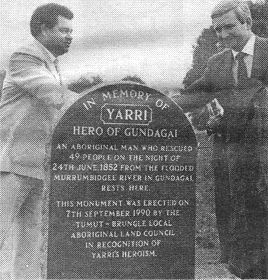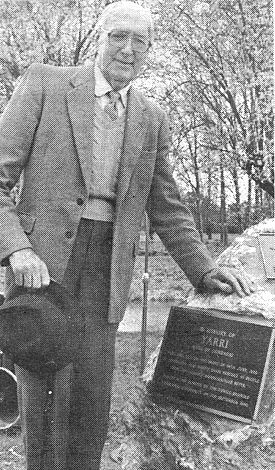There was a gathering of survivors of
the 1852 Gundagai Flood in Gundagai, 8-10 June 2002, for a commemoration of
the 150th anniversary of the Flood (24 June is the actual anniversary date).
|
How an Aborigine Saved Our
Australian Branch
Was He
Yarri?
An aborigine saved the family of
HENRY
and SUSANNAH HARGREAVES from a flood of their home in Gundagai, NSW,
Australia in 1844 by the Murrumbidgee River.
HENRY and SUSANNAH and their family came to Australia in 1840. They
lost a child on the way. They camped with convicts after arrival. He
prospected for gold in the Australian Gold Rush. Many such details
appear in The Letter from HENRY to
England in 1870, summarizing his life in Australia during the 30 years
since he departed. A typically terse description from The Letter
mentions the event of interest here: |
 |
“We started on our journey down to Gundagai where
we arrived safe and I immediately engaged to work at the punt at 15 shillings a
week and ration for my family. I remained there with various success until
beginning of 1844 when we removed into a Paddock about 2 miles down the river
and began farming. We were washed away by the flood of 1844 in the month of
September. We lost no lives being saved by a blackfellow in a bark canoe.”
The extended Hargreaves family celebrated the 150th
anniversary of the coming of HENRY and SUSANNAH to Australia in October, 1990.
The event was held in Tumut, not far from Gundagai. Colin Hargreaves
masterminded and edited a commemorative book, compiled by family members:
Colin Hargreaves, editor, Henry
Hargreaves and his Descendants: The Story of a Pioneer Family 1840-1990,
privately printed, NSW, 1990.
More of the story comes from this source, p 5 (a
section written by Colin Hargreaves):
“It was in the first year of this farming
experience that the most traumatic event of their life in Australia hit them.
They were washed out by a major flood and were rescued by an aboriginal in a
bark canoe. ...
... it was necessary to secure more suitable
accommodations. Henry was able to buy half an acre of land and he built a timber
house in Gundagai which was then situated on the flat land between the river and
Morley’s Creek. ...
Their second experience of major flooding happened
in 1852 when Gundagai had its largest flood in history, the town on the flat
being completely washed away with the loss of from 80 to 100 lives in a
population of 250. Forty-nine of these were rescued by an aboriginal called Yarri in a bark canoe. This heroic occurrence has been memorialised in a
striking mural painted around the walls of the lounge bar in the Criterion Hotel
in Gundagai. Although there is no concrete evidence of the fact, this aborigine
may have been the one who saved the Hargreaves family in 1844, as it seems Yarrie remained a friend of the John Hargreaves branch for many years and lived
on their farm at Tarrabandra until his death. His shield and nulla-nulla were
presented to the Gundagai Historical Society some years ago by Dallas, a
grandson of John.
Although they lost their home and possessions, the
Hargreaves family were able to get out before the flood covered the flat and
became a raging torrent one mile wide. Apparently their experience of 1844 was
one that they did not want repeated and they sought safety in time. ...”
Several things to note:
Although HENRY had experience of one flood, and
perhaps it taught him how to escape the second one, this doesn’t explain why
he rebuilt on the flat of Gundagai. The aborigines warned the white settlers that the river was
known to flood this flat area and urged them to settle on the hills above.
Apparently this advice was ignored not once, but twice! The second time did it,
however; the town is now built above the flood plain.
The farm Tarrabandra where Yarri lived and died
was originally the farm of our WILLIAM SANDERS and his wife SARAH HARGREAVES.
They sold it to her brother John when they left for America. It occurred to me
while entering this story and that of Yarri below that the
story might actually be the other way around. Rather than Yarri living at
Tarrabandra as a friend of John Hargreaves and his family, it might be that he
saw it as their living on his land with him.
I saw the mural honoring Yarri on a visit to the
Criterion Hotel of Gundagai in
1990. The other thing that Gundagai is noted for is the Dog
on the Tucker Box. This is one of those things, like Waltzing Mathilda, that
is familiar to nearly all Aussies but almost incomprehensible to non-Aussies
“The Nulla Nulla is one
of the most deadly weapons, whether used at close quarters or thrown. The shape
may vary between tribes but is usually between half to one metre in length and
can be used as a club or throwing stick. The handle tapers to a sharp point near
the handgrip, towards the other end the handle widens into a bulb. Like the
Boomerang, a Nulla Nulla could light a fire using the same method of spinning it
quickly with downward pressure in the surface crack of a dry log and a spark was
made. Nulla Nulla was basically a throwing stick.” This is from a now defunct
web site called http://www.wirrimbah.com.au/html/artifacts.html,
as is the picture of one above.
|
"Yarri is remembered in
Gundagai dedication
[Transcription of the Southern Weekly Magazine, Cootamundra,
NSW, 24
Sep 1990, p 3, from which the photos come as well.]
More than a century after Aboriginal hero,
Yarri, pulled residents of old Gundagai from the winter waters of the flooded
Murrumbidgee, a gravestone has been erected in his memory at the North Gundagai
cemetery.
While Yarri's memory is commemorated in a number of
smaller monuments around the township, his grave was previously unmarked.
In a ceremony at Gundagai, NSW Premier Nick Greiner
unveiled the gravestone and later the Yarri Bridge at the site wherre Yarri and
his offsider Jacky pulled 40 people to safety in June 1852.
In unveiling the gravestone, Mr Greiner said
Yarri's feat had transcended race, colour and creed.
|

"NSW Premier Nick Greiner and chairman of the Tumut-Brungle
Aboriginal Land Council, James Morgan, at the unveiling of the Yarri
headstone in Gundagai." |
|
"Considering the situation for Aborigines at
the time did not evoke generosity towards white settlers, Yarri's efforts were
truly remarkable," he said.
"This simple ceremony today honours someone
whoe extraordinary love for fellow humans is an inspiring example to all."
Also speaking at the ceremony, Sue Bulger, a
teacher at the local St Patrick's School, said Yarri was a member of the
Wiradjuri tribe and probably came from Brungle between Tumut and Gundagai.
"He would have known the Bidgee and the
significance of water.
"Yarri and our people know the Murrumbidgee,
the Big Water, and the Kooris warned the citizens of Gundagai of the
danger."
Despite the warnings, old Gundagai settled on the
flats between the Murrumbidgee and its branch, Morley's Creek.
And on the night of June 25, 1852 the water rose
beyond all expectations.
With only a bark canoe, Yarri paddled through the
night plucking the survivors from treetops and roofs one at a time, working
perhaps 50 hours straight.
And while he is credited with saving 49 people,
over 200 lives were lost and Gundagai never truly recovered its promise of being
a major inland city.
At the ceremonies, organised by the Tumut-Brungle
Aboriginal Land Council through the Office of Aboriginal Affairs, were members
of Gundagai families rescued by Yarri.
|

"A member of one of the families rescued by Yarri in the
Gundagai floods of 1852, Wallace Horsley, at the memorial on Yarri
Bridge over Morley's Creek at Gundagai." |
Among them was Wallace Horsley who named a property
Yarri in 1955 and presented a memorial sundial to Gundagai in 1952.
Mr Horsley's grandfather Richard Frederick Horsley
was stranded in a tree during the flood with his fiance Jane Hemple and her
brother.
They clung to the tree for 36 hours before being
rescued by Yarri but tragically Jane Hemple slipped from the tree and was lost.
Mr Horsley added that on another Horsley property,
Yabtree, five people were on a haystack swept down the river in the floods but
were also rescued by local Aboriginals.
It was largely the efforts of Gundagai local, Allan
Crooks, who published a booklet on Yarri's deeds which inspired the Aboriginal
community.
Mr Crooks has lived within 60km of Gundagai all his
life, yet he said it was not until he had actually moved into the town that he
had first heard of the remarkable Yarri story.
Following the rescue Yarri was given a copper
shield to wear around his neck, Mr Crooks said, but never really gained the
recognition he deserved.
His partner is rescue, Jacky, is remembered even
less."
The Yarri headstone reads:
"In Memory of YARRI, Hero of Gundagai, an
aboriginal man who rescued 49 people on the night of 24th June 1852 from the
flooded Murrumbidgee River in Gundagai rests here.
This monument was erected on 27th September 1990 by
the Tumut-Brungle Local Aboriginal Land Council in recognition of Yarri's
heroism."


